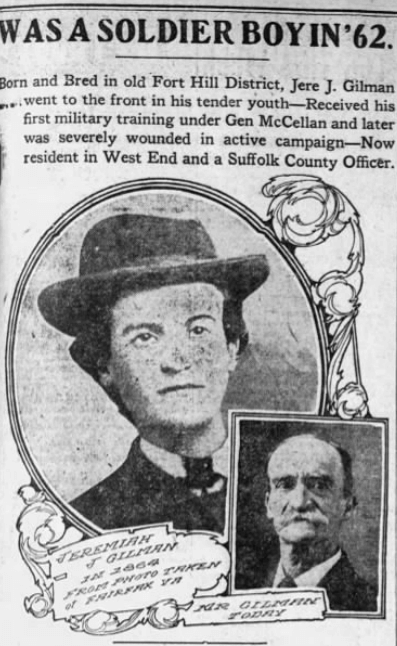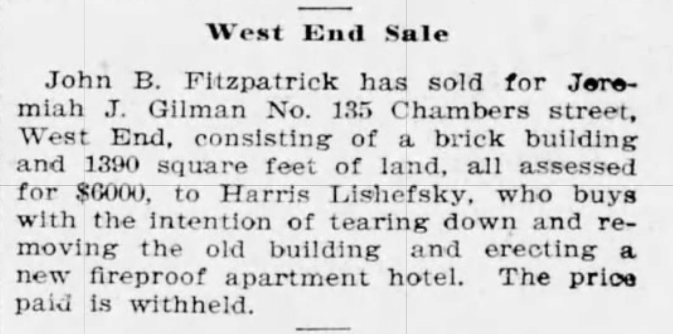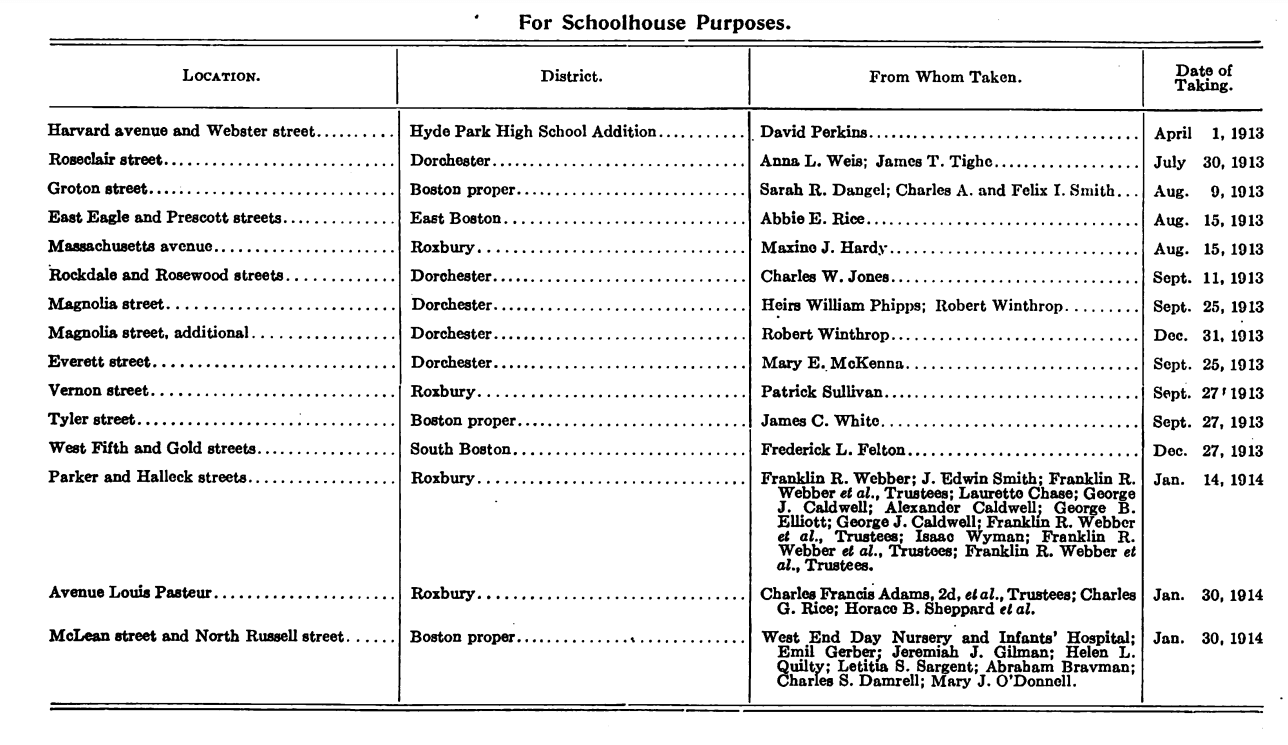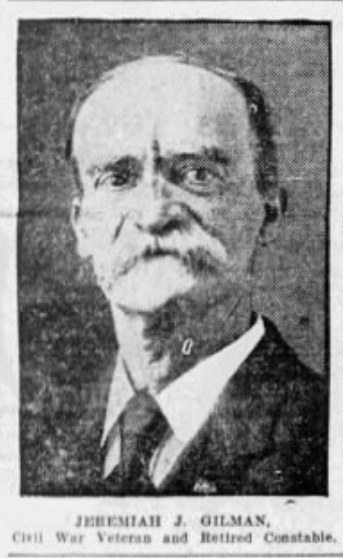Jeremiah J. Gilman
Jeremiah J. Gilman, a Civil War veteran who lived on Chambers Street and Eaton Street in the West End, witnessed the immediate aftermath of President Abraham Lincoln’s assassination on April 14, 1865. After the Civil War, Gilman made it in the local newspapers not only as a veteran, but also as the purchaser of an investment property on Eaton St. that later became his home.
Jeremiah J. Gilman was born on July 18, 1847 on Congress St. in South Boston, and grew up in the Fort Hill district of Roxbury. In 1861, when the Civil War began, Gilman was inspired to enlist in the Union Army, at thirteen years old, as a drummer. By spring 1862, Gilman arrived at Hall’s Hill, Virginia where the 22nd Massachusetts Infantry Regiment, mostly Boston residents, trained under General George McClellan. The higher-ups did not allow Gilman, despite being properly enlisted, to become a drummer on account of his “extreme youth” and there being a sufficient number of drummers as the law required. Gilman was permitted to stay as the servant of Captain Walter Sampson and perform duties at the Regiment’s headquarters. Gilman saw President Abraham Lincoln for the first time when the 22nd Massachusetts marched into Bailey’s Crossroads in Virginia. He recalled how “the immortal Lincoln…looked in his quaint stovepipe hat and long legs astride a very small horse,” in the words of the Globe. When the 22nd evacuated Yorktown on May 22, 1862, Gilman lagged behind as he was carrying Captain Sampson’s bags. He ran into the 9th Massachusetts (who shared the camp of the 22nd), picked up a musket, and joined them in combat that resulted in capturing 700 Confederate prisoners. Gilman received the opportunity to fight with the 22nd at Mechanicsville on June 26, 1862. Sent back home to Massachusetts early to assist with recruitment, Gilman joined two more regiments, the 55th “Corcoran Legion” and the 1st Massachusetts veteran regiment in 1863, and he was wounded in combat three times.
Jeremiah Gilman’s parents moved to the West End in 1863, while he was still serving. The evening of April 14, 1865, Gilman witnessed the immediate aftermath of Lincoln’s assassination. Gilman was headed to Washington, D.C. with fellow soldier Jack Bailey to see “Our American Cousin” at Ford’s Theatre. Gilman knew one of the actors, Harry Hawkes, from Boston. Standing in front of the building, Gilman saw Lincoln’s body carried out the doors of Ford’s Theatre to a small house nearby. He recalled, “as they passed me I was within three or four feet of the President and got a glance for the moment of his sad, pale face. I shall never forget the sight as he was taken past me.” Gilman returned to the West End in 1865, and married Christina Shaw in 1874; they lived at 135 Chambers Street in a brick building of 1,390 square feet. Gilman purchased a new home on 65 Prospect Street in Cambridge in 1899, and in 1901 he sold the 135 Chambers St. building to Harris Lishefsky. Lishefsky intended to tear down the home, assessed at $6,000, to build a “new fireproof apartment hotel.” By 1910, when the Globe ran its profile of Gilman’s Civil War service, he lived at 20 Eaton Street in the West End with Christina Shaw “and a family of grown-up children.” Gilman worked as a mason and plasterer in the West End for eighteen years after his military service. In 1903 he became a constable and worked at the Suffolk County courthouse, making $24/week driving a prison wagon.
Gilman originally purchased his home on Eaton St. as an investment property. On November 9, 1895, auctioneer John Fitzpatrick announced that the estates of 20, 21, and 22 Eaton St. would be sold to the highest bidder three days later. Fitzpatrick noted that the properties were well-suited as rentals and would command a high return on investment “being situated in the best portion of the West End, where property is in demand, always rented and increasingly daily in valuation.” On November 12, 1895, Fitzpatrick sold 21 Eaton St., a brick building of 1,600 square feet that could house four families, to Jeremiah J. Gilman for $6,000 (assessed at $6,500). John Crane purchased 20 and 22 Eaton St. for $4,850; the Globe reported that “both purchasers buy for investment.” Gilman eventually made 21 Eaton St. his residence, though by 1910 he moved into 20 Eaton St., having also purchased the building on 22 Eaton Street while selling 21 Eaton St. In June 1914, the City of Boston paid Gilman $6,600 after taking via eminent domain “two frame houses and 1469 square feet of land, 20 and 22 Eaton St., near the junction of North Russell St.” On January 30, 1914, the City declared its taking of land, to build a schoolhouse, from Jeremiah J. Gilman the West End Day Nursery and Infants’ Hospital, and six other residents; one of those residents, Helen Quilty, owned 21 Eaton St. The Schoolhouse Commission considered taking land owned by Massachusetts General Hospital, but after strong objections to that idea decided on taking the Eaton Street properties.
Jeremiah J. Gilman’s Civil War pension from the State of Massachusetts, went into effect on May 1, 1913, and on that day he retired. The Globe, announcing Gilman’s pension, noted that he “has always been a staunch Democrat and supporter of Martin Lomasney,” the West End’s political boss. Well into old age, Gilman never stopped telling people the stories of the two occasions that he saw President Lincoln. Gilman, at the age of 81, died in 1927 at his home, a new address of 2 Walker Terrace in Cambridge. His funeral was held the afternoon of April 16, 1927. Gilman was buried at Mt. Auburn Cemetery with fourteen Civil War veterans and representatives from military organizations in attendance.
Article by Adam Tomasi
Source: Boston Evening Transcript (“Estate in Prospect Street, Cambridge, Sold,” April 22, 1899, page 7; “West End Sale,” January 28, 1901, page 3), Boston Globe (“John B. Fitzpatrick, Auctioneer,” November 9, 1895, page 11; “Real Estate Matters,” November 13, 1895, page 9; “Deaths,” October 20, 1898, page 7; “Was a Soldier Boy in ‘62,” May 29, 1910, page 47; “Retires on Pension,” April 28, 1913, page 13; “Real Estate Transactions,” June 4, 1914, page 18; “Brennan Sues for $180,” January 20, 1917, page 14), Officials and Employees of the City of Boston (1908), Documents of the City of Boston for the Year 1914, in Four Volumes (1915)











